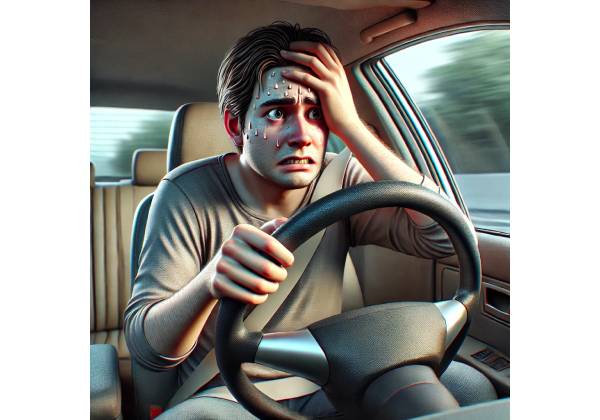
What is amaxophobia?
Amaxophobia is an anxiety disorder defined by a strong and irrational fear of driving or being in a vehicle. This particular phobia can be crippling, causing sufferers to avoid traveling by car, bus, or other modes of transportation entirely. The term is derived from the Greek words “amaxa,” meaning vehicle, and “phobos,” which means fear. While it is normal to feel anxious when driving in high-risk situations, such as inclement weather or heavy traffic, people who have amaxophobia experience overwhelming and persistent fear, even in routine driving conditions.
This phobia affects not only the driver but also the passengers, who may feel out of control or fear an accident. For some people, just the thought of being in a car can cause severe anxiety, significantly impairing their ability to function in everyday life. Amaxophobia is frequently associated with other anxiety disorders, such as generalized anxiety disorder or panic disorder, which complicates its impact on the individual’s health.
Living with amaxophobia can severely limit personal freedom and social interaction, as transportation is an essential component of modern life. Those affected may avoid certain activities or opportunities due to a fear of driving, resulting in isolation or difficulty maintaining relationships. Understanding and treating this phobia using comprehensive treatment approaches can help people regain confidence and autonomy in their daily lives.
What are the symptoms of Amaxophobia?
Amaxophobia is characterized by a range of symptoms, including mild anxiety and severe panic attacks. These symptoms can appear both physically and psychologically, and they are frequently triggered by being in a vehicle, thinking about driving, or planning a car ride. Recognizing these symptoms is critical for diagnosing the phobia and devising a successful treatment plan.
Physical Symptoms
When people with amaxophobia are confronted with the prospect of driving or riding in a vehicle, their bodies may exhibit a variety of physical symptoms of anxiety. These physical symptoms are part of the body’s natural response to perceived danger and may include:
- Increased heart rate (tachycardia): As anxiety builds, the heart rate rises, preparing the body for a “fight or flight” response.
- Shortness of breath: Breathing may become shallow or rapid, particularly during times of intense fear. In severe cases, hyperventilation may occur.
- Sweating: People may sweat excessively, especially if they feel trapped or unable to get out of a vehicle.
- Trembling or shaking: Anxiety can cause uncontrollable tremors, particularly in the hands and legs.
- Nausea or gastrointestinal distress: Some people may feel sick to their stomach or have nausea during or before a car ride.
- Dizziness or lightheadedness: Feelings of faintness may accompany anxiety, particularly if the individual is experiencing extreme fear or panic.
- Chest tightness or discomfort: Anxiety can cause tension in the chest, making it feel tight or painful, mimicking the symptoms of a heart attack in extreme cases.
Psychological and Emotional Symptoms
The emotional and psychological consequences of amaxophobia can be equally severe. These symptoms frequently appear in anticipation of driving or riding in a vehicle, and they can last long after the experience has ended. Some common psychological symptoms are:
- Intense fear or dread: People with amaxophobia may experience overwhelming fear at the prospect of getting into a car, even if others consider the situation safe.
- Catastrophic thinking: People with this phobia frequently imagine the worst-case scenarios, such as fatal accidents, severe injury, or losing control of the vehicle. These thoughts can be paralyzing, resulting in avoidance behaviors.
- Panic attacks: In severe cases, people may experience panic attacks when confronted with their fears. A panic attack is characterized by a rapid heart rate, shortness of breath, chest pain, and a sense of impending doom.
- Avoidance behaviors: Many people with amaxophobia go to great lengths to avoid driving or traveling in a car. This could include refusing to drive, avoiding certain roads, or declining social invitations requiring vehicle travel.
Behavioral Symptoms
Amaxophobia frequently results in behavior changes that severely limit a person’s daily life. Typical behavioral adaptations include:
- Avoiding driving or car rides: People with amaxophobia may refuse to drive or ride in a vehicle at all, even if it means missing important events, work, or family gatherings.
- Reliance on others: Many people with amaxophobia rely on friends, family, or public transportation to get around, which can strain relationships and limit independence.
- Excessive planning or safety measures: Some people may feel compelled to over-prepare for any car trip, taking extreme precautions to ensure their safety, such as only driving at certain times of day or in specific conditions.
Cognitive symptoms
The cognitive distortions that accompany amaxophobia can exacerbate the condition by reinforcing the fear and anxiety that comes with driving. Cognitive symptoms could include:
- Overestimation of risk: People with amaxophobia exaggerate the dangers of driving, believing that accidents are unavoidable or far more likely than they are.
- Focus on worst-case scenarios: People with this phobia frequently fixate on potential disasters, making it difficult to concentrate on the reality of the situation or the likelihood of harm.
- Intrusive thoughts: Persistent, unwanted thoughts about car accidents or losing control of the vehicle can take over a person’s mind, even when they are not driving or in a car.
Identifying these symptoms is the first step in diagnosing and treating amaxophobia. Addressing the physical, emotional, and behavioral aspects of the phobia is critical to restoring individuals’ confidence and autonomy.
Causes and Risk Factors for Amaxophobia
Amaxophobia, like many other specific phobias, can develop as a result of psychological, environmental, and genetic factors. While everyone’s experience with amaxophobia is different, there are some common causes and risk factors that contribute to the development of this fear.
Psychological Causes
- Past traumatic experiences: One of the most common causes of amaxophobia is a traumatic event such as a car accident or close call. Individuals who have been involved in or witnessed a serious car accident may develop a long-term fear of driving or being in vehicles, even if they were not physically injured.
- Generalized anxiety disorder (GAD): People with a history of anxiety disorders may be more likely to develop specific phobias, such as amaxophobia. Their increased sensitivity to perceived threats may lead them to regard driving as an inherently dangerous activity.
- Panic disorder: Amaxophobia is frequently associated with panic disorder, especially if the patient has had panic attacks while driving. The fear of having another panic attack behind the wheel can lead to complete avoidance of driving.
Environmental Factors
- Overprotective upbringing: Children who were raised in environments that portrayed driving as dangerous or risky may develop amaxophobia as adults. If parents or caregivers consistently express fear or anxiety about driving, these attitudes may be internalized.
- Cultural influences: In some cultures, there may be a greater emphasis on the dangers of driving or strict social norms surrounding safety, resulting in a higher prevalence of amaxophobia in certain populations.
Genetic and Biological Factors
- Genetics: Research indicates that phobias may have a genetic component. People who have a family history of anxiety disorders, phobias, or panic disorder may be more likely to develop amaxophobia.
- Brain chemistry: Imbalances in neurotransmitters such as serotonin and dopamine can affect how a person feels anxious and fearful. Individuals with such imbalances may be more likely to develop phobias such as amaxophobia.
Risk Factors
Amaxophobia can be caused by a number of risk factors, which include:
- Previous automobile accidents or near misses.
- A family history of anxiety or phobias.
- Panic attacks while driving.
- Generalized Anxiety Disorder.
- Overprotective upbringing or cultural attitudes toward driving safety.
Understanding the causes and risk factors of amaxophobia can assist individuals and healthcare providers in identifying the source of the phobia and developing targeted treatment plans.
How is Amaxophobia diagnosed?
Amaxophobia is typically diagnosed through a comprehensive evaluation by a mental health professional. This process entails evaluating the individual’s symptoms, comprehending their fear of driving, and ruling out any other possible causes of their anxiety. A formal diagnosis is required to create an effective treatment plan.
Clinical Interviews
Mental health professionals frequently begin by conducting a thorough clinical interview. During the interview, the clinician will ask the individual about their driving experiences, specific fears, and how these fears affect their daily lives. The goal is to gain a comprehensive understanding of the individual’s anxiety and how it influences their behavior.
Diagnostic Criteria
Amaxophobia is classified as a specific phobia in the **Diagnostic and Statistical Manual of Mental Disorders (DSM-5). To meet the diagnostic criteria, the individual must demonstrate:
- Extreme and irrational fear of driving or being in a vehicle.
- Persistent fear for six months or more.
- Avoidance behavior, such as refusing to drive or avoiding specific roads or routes.
- Significant distress or disruption to daily activities.
Psychological Assessment Tools
Clinicians may use standardized tools or questionnaires to determine the severity of the phobia. These tests help to quantify the level of anxiety and determine the best course of treatment. Tools such as the Fear of Driving Questionnaire (FDQ) or Generalized Anxiety Disorder Assessment (GAD-7) may be used to gain a better understanding of the individual’s condition.
Rules Out Other Conditions
It’s critical to rule out other possibilities for the individual’s symptoms, such as panic disorder, post-traumatic stress disorder (PTSD)**, or generalized anxiety disorder (GAD). Although these conditions can coexist with amaxophobia, the phobia must be distinct rather than a symptom of another anxiety disorder. This distinction ensures that the treatment is tailored specifically to the fear of driving or being in a vehicle.
The Effect of Amaxophobia on Daily Life
Amaxophobia can have a significant and long-term impact on an individual’s life, affecting their personal, professional, and social well-being. Because driving is such an important part of modern life, fear of being in a vehicle can severely impair a person’s ability to function normally.
Social Isolation and Relationship Strain
Individuals suffering from amaxophobia may experience social isolation as a result of their inability or unwillingness to drive. They may avoid visiting friends and family, attending social gatherings, or engaging in activities that require driving or being a passenger. This can strain relationships and cause feelings of loneliness.
- Declining invitations: People with amaxophobia may frequently decline social invitations that require driving, particularly if public transportation or other alternatives are unavailable.
- Dependency on others: People who avoid driving may become reliant on others for transportation, straining personal relationships. Friends, family members, or partners may feel burdened by the constant need to provide rides or accommodate the individual’s fears.
Career Limitations
Amaxophobia can have a negative impact on a person’s career. Many jobs necessitate some level of travel, whether commuting to work or attending meetings and events. The inability to drive can limit career opportunities and advancement.
- Difficulty commuting: Those with amaxophobia may find it difficult to commute to work if public transportation is unavailable or if the commute requires driving on highways or in congested traffic, both of which are common triggers for people with this phobia.
- Limited career opportunities: Some jobs, such as sales positions, delivery services, or travel-related management roles, require driving as a core responsibility. Amaxophobia can hinder career advancement or prevent people from pursuing certain professions.
Emotional and Mental Health Strain
Living with amaxophobia can cause serious emotional and mental health issues, such as chronic stress, anxiety, and depression. The constant avoidance of driving, combined with the restrictions it imposes on daily life, can heighten feelings of frustration, helplessness, and inadequacy.
- Increased anxiety: Anticipating situations requiring driving can cause chronic stress and heightened anxiety, even in non-driving situations.
- Depression: The social isolation and limitations imposed by amaxophobia can cause feelings of hopelessness and depression, especially if the person believes they are missing out on important life events or opportunities.
Best Treatment Options for Amaxophobia
Amaxophobia can be effectively treated by addressing both its psychological and physical aspects. While each individual’s response to treatment may differ, several approaches have been shown to be effective in reducing fear of driving and restoring confidence.
Cognitive-Behavioral Therapy (CBT)
Cognitive Behavioral Therapy (CBT) is a highly effective treatment for amaxophobia. CBT helps people recognize and change negative thought patterns that contribute to their fear of driving. This structured, goal-oriented therapy is usually delivered by a trained therapist and focuses on a few key techniques:
- Cognitive restructuring: Cognitive restructuring assists individuals in identifying and challenging irrational thoughts about driving, such as overestimating the risk of an accident or fearing they will lose control of their vehicle.
- Exposure therapy: Gradual exposure to driving-related situations is an essential component of cognitive behavioral therapy for amaxophobia. Exposure therapy entails beginning with less anxiety-inducing scenarios, such as sitting in a parked car or driving on a quiet street, and gradually progressing to more difficult situations, such as driving on highways or in traffic.
- Behavioral experiments: CBT encourages people to test their catastrophic thoughts by participating in driving-related activities in a safe and supportive environment. This allows them to gather evidence that challenges their fears and gradually builds their confidence.
Virtual reality exposure therapy (VRET)
Virtual Reality Exposure Therapy (VRET) is a novel treatment for specific phobias, such as amaxophobia. VRET enables people to simulate driving experiences in a virtual environment, eliminating the need for an actual vehicle. This method is especially beneficial for people who are too afraid to start traditional exposure therapy right away.
- Safe and controlled environment: VRET offers individuals a safe and controlled environment in which to confront their fear of driving, without the real-world consequences of driving.
- Gradual progression: VRET, like traditional exposure therapy, gradually increases the intensity of driving scenarios, allowing individuals to build tolerance and reduce anxiety.
- Customizable experiences: VRET can be tailored to address specific fears, such as driving on highways, crossing bridges, or navigating congested traffic, making it extremely adaptable to each individual’s requirements.
Mindfulness and Relaxation Techniques
Mindfulness and relaxation techniques can help people with amaxophobia manage their physical symptoms of anxiety, such as rapid heartbeat, shortness of breath, and muscle tension. These techniques aim to help people stay present and calm in stressful situations, such as driving.
- Mindfulness meditation: Mindfulness exercises teach people to focus on the present moment without judgment, which can help them manage their anxiety when they become overwhelmed by their fear of driving.
- Breathing exercises: Controlled breathing techniques, such as deep breathing or diaphragmatic breathing, can help reduce physical symptoms of anxiety and calm the nervous system when a person becomes panicked in a vehicle.
- Progressive muscle relaxation (PMR): PMR entails tensing and then relaxing various muscle groups in order to reduce overall tension and create a sense of calm, which can be beneficial during stressful driving situations.
Medications
In some cases, medications may be prescribed to help manage the symptoms of amaxophobia, especially if the individual’s anxiety is severe or interferes with daily life. Medications are typically used in conjunction with therapy, rather than as a standalone treatment.
- Selective serotonin reuptake inhibitors (SSRIs): SSRIs, such as sertraline (Zoloft) or fluoxetine (Prozac), are frequently used to treat anxiety disorders. These medications help to regulate serotonin levels in the brain, lowering overall anxiety and fear responses.
- Benzodiazepines: Benzodiazepines, including lorazepam (Ativan) and diazepam (Valium), are anti-anxiety medications that can provide temporary relief from acute anxiety. However, because of the risk of dependency, they are rarely recommended for long-term use.
- Beta-blockers: Beta-blockers, such as propranolol, can help manage the physical symptoms of anxiety, such as rapid heartbeat and trembling, in situations where the individual expects heightened fear, such as driving.
Group Therapy and Support
Group therapy and support groups can be extremely beneficial for people who suffer from amaxophobia. These settings offer a safe environment in which people can share their experiences, learn coping strategies, and practice facing their fears.
- Peer support: Connecting with others who share similar fears can help alleviate feelings of isolation and provide encouragement during the recovery process.
- Group exposure therapy: In some cases, group therapy sessions may include exposure exercises, which allow people to confront their fear of driving in a safe and collaborative environment.
Lifestyle Changes and Self-help Strategies
In addition to professional treatment, certain lifestyle changes and self-help techniques can help people manage amaxophobia and reduce anxiety triggers.
- Regular physical activity: Studies have shown that exercise can reduce anxiety by releasing endorphins and improving overall mental health. Regular physical activity can help people manage stress and become more resilient to anxiety.
- Adequate sleep and nutrition: Eating a balanced diet and getting enough sleep are critical for regulating mood and lowering anxiety levels.
- Gradual exposure to driving: For people who are just starting to overcome their fear of driving, starting with short, low-stress drives and gradually increasing the distance or complexity of the route can help build confidence.
Individuals with amaxophobia can gradually overcome their fear of driving by combining therapeutic approaches, medications (if necessary), and lifestyle changes.










